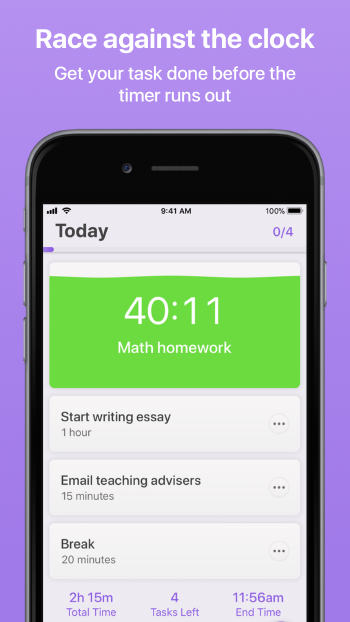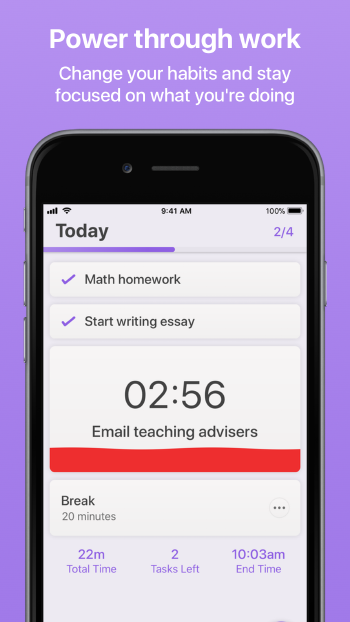News
Freshman Shaan Singh has developed a productivity app designed to help his peers avoid distractions, buckle down, and complete work before deadlines strike. (Photo provided by Shaan Singh)
Midnight cram sessions and frantic prototyping marathons are evidence that even students at the Harvard John A. Paulson School of Engineering and Applied Sciences (SEAS) aren’t immune from the scourge of procrastination.
With Time 2, freshman Shaan Singh has developed a productivity app designed to help his peers avoid distractions, buckle down, and complete work before deadlines strike. Time 2 is the second version of an app Singh developed while in high school.
“It came out of necessity because I never could stay focused on homework for a long time,” Singh said. “But if I had something pressuring me to get my work done, even just a kitchen timer counting down, I would stay focused. I wanted to beat the clock.”
 Inspired by the Pomodoro Technique—a time management method developed in the 1980s that uses a timer to break down tasks into 25-minute intervals—Singh sought to develop a tool to make the technique’s fundamental concepts more approachable and user-friendly.
Inspired by the Pomodoro Technique—a time management method developed in the 1980s that uses a timer to break down tasks into 25-minute intervals—Singh sought to develop a tool to make the technique’s fundamental concepts more approachable and user-friendly.
In 2015, the high school sophomore joined forces with Erik van der Plas, then a 14-year-old student in the Netherlands, to develop the Time app. Singh and van der Plas met at Apple’s Worldwide Developers Conference after winning student scholarships from Apple. They found that they shared a passion for engineering and design, as well as a bad procrastination habit.
The app’s initial version, launched in early 2017, enabled users to add a task and a time limit to complete it, then start a visual countdown that changed colors from green, to yellow, to red as the deadline approached.
“It seems very simple, but when you have the app open next to you while you’re working, you’ll actually be more inclined to stay focused,” Singh said. “You’ll see the timer next to you counting down and it is an instinctive, race-against-the-clock mentality. We’re all human and we’re all naturally competitive. It is that psychology the app takes advantage of.”
Less than a week after it launched, the app shot to number 39 in the App Store’s productivity section, and quickly climbed to the number 2 spot.
Buoyed by that success, Singh and van der Plas began working on a new version. Time 2 offers expanded features, such as the ability to input tasks for future dates, add repeating tasks, and set reminders. According to Singh, the goal of the new app is “to be a replacement for your calendar or agenda book. It can do everything they can do, but better.”
In addition, Time 2 will send a push notification warning users not to get distracted if they leave the app and get sidetracked by Facebook, Instagram, or other social media instead of working. Finally, the app introduces a daily progress meter, which tracks a user’s overall progress on completing all tasks for that day.
“If you have one task left and it’s late and you’re feeling lazy, it is very easy to procrastinate. But as humans, we tend to have a completionist attitude. We want to finish things that we start,” he said. “That progress bar is there as a little kick to get you to finish everything you need to do.”
For Singh, who began teaching himself to code at age 8 and quickly moved into iOS development before his teenage years, it has been rewarding to watch the success of Time and Time 2. Ironically, the biggest challenges of developing the app often came down to time management, since Singh was a full-time student and half of a two-person development team. He recalled often staying up into the wee hours of the morning (instead of finishing his high school homework) to fix critical errors during the app’s early days.
 Now at Harvard, he’s exploring new outlets for his passion for computer science, drawing on other work from his youth. During high school, he worked at the University of Maryland and Johns Hopkins Medical Institute on a research project studying how computer vision and machine learning could be used to diagnose autism spectrum disorder.
Now at Harvard, he’s exploring new outlets for his passion for computer science, drawing on other work from his youth. During high school, he worked at the University of Maryland and Johns Hopkins Medical Institute on a research project studying how computer vision and machine learning could be used to diagnose autism spectrum disorder.
That project, soon to enter human trials, involves examining facial expressions related to the six classifiable emotions (anger, disgust, fear, happiness, sadness, and surprise). A non-autistic child might express happiness by smiling and raising her eyebrows, he explained, while an autistic child’s happiness expression could involve a completely different set of micro-expressions. By using machine learning to compare all six emotions, the researchers hope to provide insights into where an individual lies on the autism spectrum.
Drawing on that research, Singh launched a new project, Express, that uses machine learning to find faces in an image and determine which emotions are being displayed. The company he founded, Blue Cocoa, continues to explore other technologies, and is pursuing a new project involving magnets and augmented reality.
“I’m interested in a lot of different things—machine learning, art, design, psychology,” Singh said. “But all of it boils down to making an impact. If you can combine art and the humanities with technology and science to create something new and original, you can actually help people live better lives. And that’s all that matters.”
Time 2 Launch Video
Topics: AI / Machine Learning, Computer Science, Entrepreneurship
Cutting-edge science delivered direct to your inbox.
Join the Harvard SEAS mailing list.
Press Contact
Adam Zewe | 617-496-5878 | azewe@seas.harvard.edu



